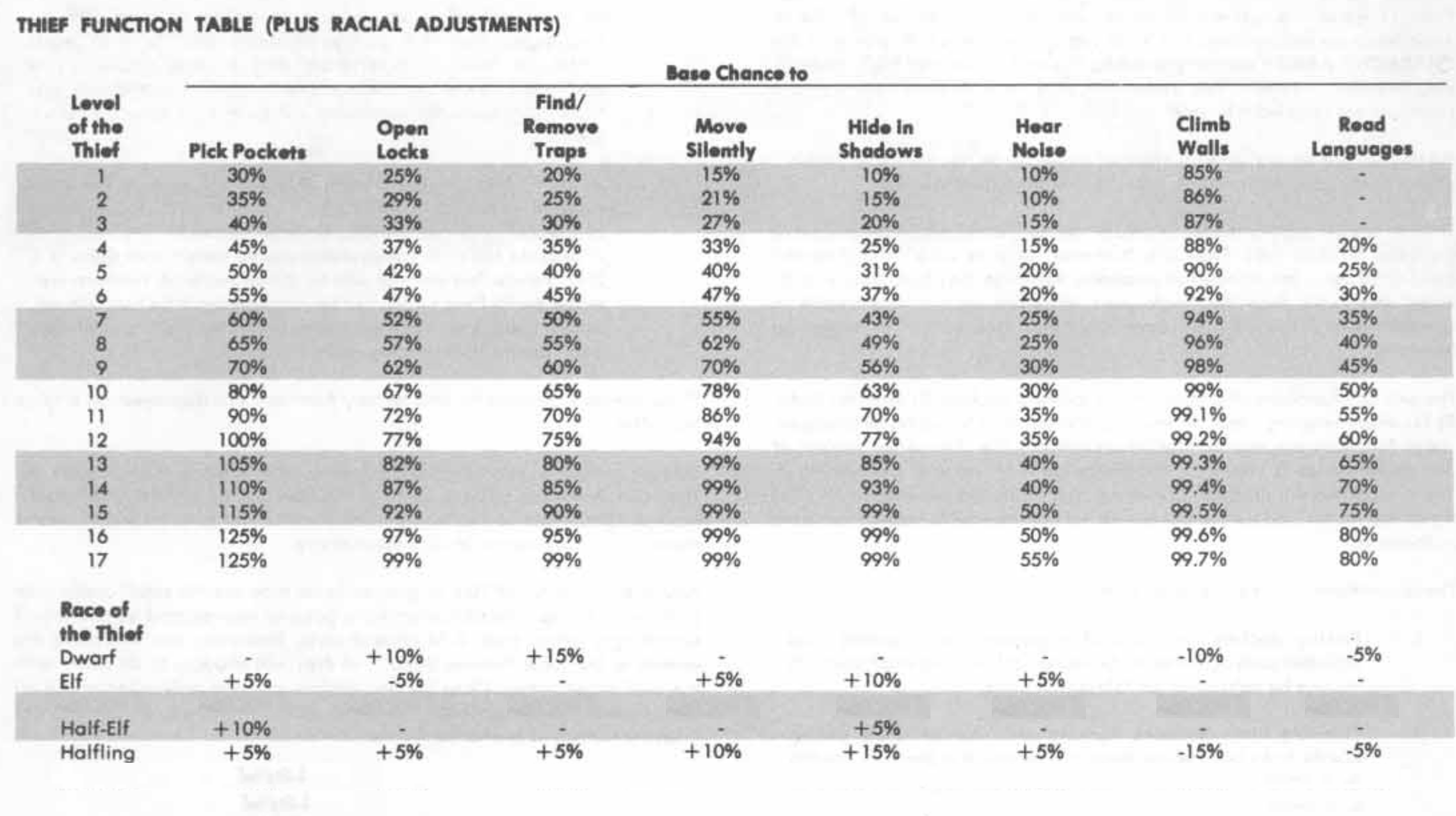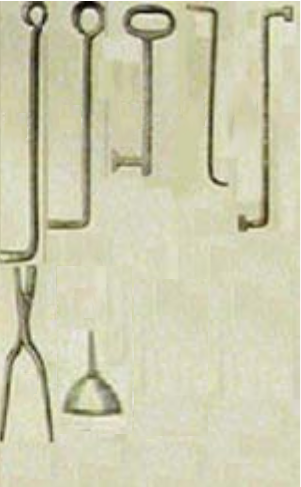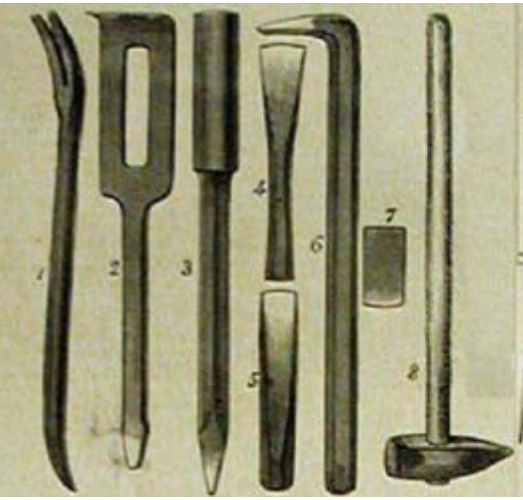Thieves in my Titan campaign are being upgraded and changed a bit.
The first change is combat.
It seems illogical that clerics are better fighters then street savvy criminals! While the ‘fighting friar’ is the archetype of AD&D Clerics (and I am not going to change that) Thieves should be at least as good as clerics in a rumble. Consequently, Thieves will use the 1.A. Attack Matrix for Clerics, Druid and Monks when rolling for combat.
Armor and weapon limitations remain unchanged.
Back Stabbing
The basics of Back Stab remains the same. Extra damage inflicted that increases as the Thief goes up in level. The changes are thus: The attack must be a Surprise, but does not necessarily have to be from behind. A successful ‘back stab’ can be executed from the side or even the front if the target is surprised and taken unaware. Of course this is unlikely to happen in a full on combat situation, in that case the attack will usually need to be from behind. But if the thief has contrived a way to get close to an unsuspecting target, say in a crowded tavern, he or she may execute the ‘stab’ from in front or behind. The key is surprise, not position. The victim must be Surprised, a normal surprise roll of d6 is made, and on a 1 or 2, the target would be surprised. If the thief is creeping up on someone from behind, in the dark, then they use their Move Silently score to determine success.
Additionally, a Thief may use a missile attack for a ‘back stab.’ There are limits on this. A thief throwing a dagger or using a bow, can ONLY make the ‘stab’ attempt on the FIRST shot or throw. A thief attempting an arrow shot from a dark alley, window or from a tree branch, must succeed with a Hide in Shadow roll to have the surprise needed for the shot. Hit or miss, the second shot is a normal attack.
Specializations
A Thief may choose to specialize in a particular style of criminal activity. This is purely optional, the character can opt to remain a ‘jack of all trades’ without specializing in any. Specializing in a particular area enhances the thief’s ability in that area but does so at the a cost in less utilized areas and skills. If desired, a specialization must be selected at the start of the thief’s career.
Pick Pocket
The Pick Pocket earns most of their ill-gotten gain by stealing from passers-by, in crowded markets and other places where it is easy for them to closely approach others, filch coins or small items, and get away unnoticed. Many halflings prefer this Thieving Style. A Pick Pocket gets a +20% bonus to all such rolls. The Pick Pocket has a -10% penalty to all other thieving abilities.
Mechanic
A ‘Mechanic’ is skilled in all thing mechanical, enjoying the challenge of picking locks, cracking open safes, and detecting and disabling (or setting!) traps. This Thieving Style is often preferred by dwarves. The character receives a +15% bonus to their rolls for the skills Open Locks, and Find/Remove Traps. The Mechanic has a -10% penalty to all other thieving abilities.
Cat Burglar
The Cat Burglar specializes at sneaking into inaccessible places and moving about undetected. Elves and half-elves often prefer this Thieving Style. The Cat Burglar receives a +10% bonus to the skills Move Silently and Hide In Shadows.
In addition, the Cat Burglar receives a +5% bonus to Climb Walls, again, with an automatic reroll of failed attempts (but see page 19 of the DMG for modifiers based on conditions of the surface being climbed).
Like their namesakes, Cat Burglars are trained to land safely, so should the Cat Burglar fall from any height, they are allowed to deduct 1d6 for every one of their experience levels from the damage they take. Thus, a 4th level thief who has the Cat Burglar style deducts 4d6 hit points from falling damage they take. The Cat Burglar has a -10% penalty to all other thieving abilities.
Confidence Artist
The Confidence Artist is glib, charming, persuasive, and usually physically attractive, easily able to “read” people and tell them what they want to hear. This skilled liar is often able to persuade others to do almost anything the Confidence Artist suggests, including “investing” in the thief’s fraudulent “business proposals,” or even granting the thief positions of authority (which they will abuse for their own benefit).
The Confidence Artist gains a +10% bonus to all NPC reaction rolls, in addition to other bonuses for high Charisma (a must for this Thieving Style). The Con Artist must be able to speak the language of the NPC, or at least a common language. Successful and detailed communication is key.
Reliance on their interpersonal skills has dulled the thief’s other abilities, so they must accept a -10% penalty on all the usual thieving abilities (Pick Pockets, Open Locks, Find/Remove Traps, etc.).
Street Wise
This is a new ability for thieves.
This Thief ability lets the thief get a feel for what’s going on in the town or city: He or she can glean the concerns of the population or city officials, the recent focus of the Watch, and the activities and machinations of local thieves. This is done by Seeking Information (see the description below.)
Street Wise may also alert him to street activity he observes. The character may detect a Thief shadowing or setting up a Mark for a Pick Pocket or casing a house, notice the Watch setting up a raid, or other activities happening or about to happen that a normal person might not realize.
Additionally, Street Wise enables the thief to assess the value of non magical loot such as jewels, furs, ivory, and other “normal” items. AND assists the thief in finding a buyer, a Fence, to purchase such loot as well as obtaining questionable goods like Thieves Tools, poisons, illegal contraband and so on. Successful Street Wise rolls will also aid in negotiating the price with the Fence or supplier. (Charisma adjustments can apply.)
Seeking Information. This allows the thief to obtain information from “street” sources on subjects of interest to the character. Such sources include merchants, other thieves, tavern patrons, prostitutes, pimps, beggars, vagrants, urchins, informants, overhears, rumors, etc. Assuming that the thief is in a familiar locale, city or town, it takes a full 12 hours of skulking, lurking, listening, buying drinks, schmoozing and general observing to have a chance to learn anything. If the thief is in a new town or city it will take 2d4 12 hour sessions to have any chance of learning anything interesting as the thief needs to familiarize themselves with the neighborhoods, taverns and dives, and begin establishing friendly relations with the locals.
Generally speaking, a thief mingling with a crowd that is the same race as he or she, has a better chance of overhearing something useful. A human thief in a tavern full of Dwarves will stand out and those around him, being more aware of his presence, may guard their tongue. The chance of learning something interesting is reduced by 5% if the majority of the general population is a race other then the thief’s. The only exception to this is a Halfling Thief. Halflings are often overlooked by ‘the bigger folk’ or are accepted and ignored by those of similar size. Humans in particular often treat halflings like human children, overlooking their presence in a busy environment. Halfling thieves have no penalty for mingling with other races when seeking information.
The cost will be 4D6 GP per 12 hours of seeking information. The type of information is often superficial but may potentially be more useful than a normal character might be able to obtain because the seedier elements of town sometimes know useful “secrets” the proper folk of Society do not.
Adjustment to roll: +5 for each extra 25 GP spent in tips and bribes to a maximum of 15%.
The percentage may be halved, or more, and the cost increased 100 fold+ if the character wants highly specific (or suspicious) information about a particularly influential person or thing. And, there is always a chance someone may “rat out” the character.
|
Street Wise Table |
|
|
Thief Level |
% Chance of success |
|
1st |
15% |
|
2nd |
20% |
|
3rd |
25% |
|
4th |
30% |
|
5th |
35% |
|
6th |
40% |
|
7th |
45% |
|
8th |
50% |
|
9th |
55% |
|
10th |
60% |
|
11th |
65% |
|
12th |
70% |
|
13th |
75% |
|
14th |
80% |
|
15th |
85% |
|
16th |
90% |
|
17th |
95% |
|
18th |
100% |
|
19th |
105% |
|
20th |
110% |
Hiding and Hide in Shadows
A Thief’s ability to hide is not limited to hiding in shadows or hiding in the dark. The ability can be used in broad daylight, provided that there is cover and/or camouflage available.
Examples of Hiding in daylight: Blending into a crowd on a busy street. Creeping from boulder to boulder. Crawling through underbrush. Hiding in the trash in an alley…
Hiding in Shadows is at best problematic when dealing with creatures that possess Infravision. No matter how dark it is the thief’s own body heat can give him or her away. How much of a problem this is for the thief is dependent on two factors. First, the quality of the creature’s infravision. This varies by race, with humans, lacking any normal infravision, being the easiest to hide from. And second, the presence or absence of physical cover and any type of ‘thermal’ or light camouflage.
An area of full (non magical) darkness. (Examples: Underground without light sources, nighttime in an alley, thick foliage or deep woods, a blacked out room, etc.) gives a thief near total concealment from a human opponent (without magical aid) but also makes the thief easy to see for an opponent with Infravision.
|
Infravision effect on Hiding in Shadows |
|||
|
Quality of Infravision |
Full dark. |
With Some Cover |
With Thermal Cover |
|
None |
— |
— |
— |
|
Fair |
-10% |
-5% |
— |
|
Good |
-15% |
-10% |
-5% |
|
Very Good |
-20% |
-15% |
-10% |
Having some cover, boulders to hide behind, niches in the wall… Will reduce the infravision penalty by blocking direct views. Unless the cover is twice the size of the thief, the heat from the thief’s body may still be visible around the edges of the object. Very large objects will hide the heat signature completely.
Thermal Cover is a nearby heat source that is not generating light. Or, scattered normal (non magical) light sources such as lanterns and torches that create both light with shadows and thermal bright spots. Examples: A hot stove, a chimney wall with a burning fireplace, the exterior wall of a heated house or area, a quantity of hot ashes, a very large and warm creature…
Moving Silently
This is not a change to Thieves but rather an explanation.
As per pg68 of the DMG: “Characters in metal armor can be heard for 90′, hard boots can be heard at 60′, relatively quiet movement can be heard at 30‘.”
The 90′ for metal armor is the same as the distance for the surprise bonus that elves and halflings get when they are alone, with other elves or halflings, or at least 90′ ahead of the rest of the party.
A character that is NOT wearing metal armor and is either bare-foot of wearing soft-soled shoes or boots and moving relatively quietly, can go unheard without requiring any skill or any skill check as long as they stay more than 30′ away. If they go within 30′, they WILL be heard, and will require a Surprise Roll. If the character succeeds, they can get back out of hearing range before whoever or whatever heard you can react. If the character has hard-soled shoes or boots they WILL be heard within 60′ And if wearing metal armor, they WILL be heard within 90′.
A properly equipped Thief, using Move Silently, can attempt to approach closer then 30′. Properly equipped means leather, padded or no armor and soft soled boots or shoes. A thief will not need to make a Move Silently roll until he or she attempts to get closer then 30′ to the target or area.
NOTE: Thieves moving silently utilize the exploratory movement rate, not the 10x melee movement rate or the 1/10th melee movement rate by segment. Thus a creeping thief attempting to move silently is not moving 12 ft per segment, he is moving 1.2 ft per segment. However, once a thief is within 10′ of a target, he or she may attempt an attack.

Basic Thief Functions

Dexterity Adjustments for Thieves
Thieves Tools

Basic Thieves Tools These are concealable (mostly) on the thief. Many thieves skip the oil for easier concealment.
Hardened steel lockpicks/skeleton keys (part of normal thieves tools, light tools): 25 GP/1 lb.
Hardened steel nippers (pliers) for forcing locks open or turning picks (part of normal thieves tools, light tool): 3 GP/1 lb.
Can of fine penetrating oil for rusty locks (part of normal thieves tools, light tool): 2 GP/1lb.

These thieves tools are used when concealment is not an issue and heavy work is anticipated.
1. Claw Jimmy (heavy tool): 1 GP/2 Lbs.
2. Jimmy/screw-turner and bolt-turner/nail puller (heavy tool): 3 GP/2 Lbs.
3. Combination file/jimmy/digger/hole-maker (heavy tool): 10 GP/1 Lb.
4. Wood chisel (light tool): 1 GP/1 Lb.
5. Stone chisel (light tool): 1 GP/1 Lb.
6. Crowbar (heavy tool): 2 GP/2 Lbs.
7. Pry or door wedge (light tool): 1 GP/1 Lb.
8. Small hammer (light tool): 3 GP/2 Lbs